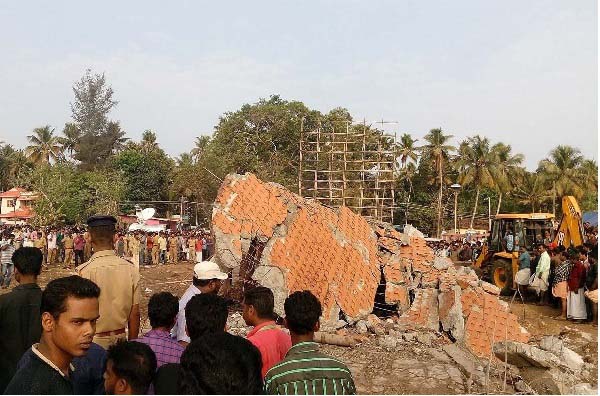
Even 8 years after India’s worst firecracker disaster in recent memory claimed 110 lives, traditional practices and flagrant violations of the law insulate such spectacles from modern options– but change is coming
By Anand Parthasarathy
Within days of each other, earlier this month, fatal accidents engulfed places in two south Indian states, where fire crackers were being manufactured or stored.
One person was killed and 25 injured in a blast in Choorakadu on February 12 in the temple town of Tripunithura in Kerala, where fireworks were being (illegally) stored in preparation for the annual festival at the nearby Puthiakavu temple.
Five days late, 10 died in an explosion in a firecracker manufacturing unit in Tamil Nadu state’s Virudhanagar district.
In October last year, 12 men were killed in a fire cracker godown in Attibele, Karnataka, even as two other explosions in and around Sivakasi, the Tamil Nadu town famous as the epicentre of cracker manufacture in India, claimed 16 lives.
It goes on and on… the deadly toll that the manufacture, transportation, storage and display of firecrackers – predominantly as part of religious ritual – extracts, year after year, in flagrant violation of all rules governing such hazardous activities.
Worst fireworks accident
The worst such disaster in recent memory occurred at the Puttingal Devi temple near the Kerala town of Kollam, on 11 April 2016, when sparks from the ongoing fireworks landed on the building where more firecrackers were stored. That night 110 died.
The Kerala Hight Court swung into action after that disaster, initiated a suo moto writ petition and sought to tighten the control on such public displays. The judge who initiated the petition wrote interestingly: “The directives in the Anand Parthasarathy vs State of Kerala case issued in 2000 were not effective to curb the menace of dangerous fireworks displays.”
At this point let me declare my personal interest in this subject. The directives cited were part of a judgment by a division bench headed by the then Kerala Chief Justice Arijit Pasayat, in a public interest case I fought for nearly a decade, which sought to curb dangerous and noisy fireworks in a temple in Tripunithura, that was across the road from my house, whose windows were annually shattered by the loud crackers. This was followed by another judgement a year later by another division bench head by Justice PK Balasubramanyan which was even more specific in pinning blame on authorities for not proactively regulating such fireworks. The judgments were cited by dozens of citizens in other states, over the years, who moved their courts when fighting the menace of noisy and dangerous fireworks mostly in places of worship, in their backyard
Sadly over two decades later, little has changed. The laws are there: the Explosives Rules of 1983; the Noise Pollution Rules of 2000 flowing from the Environment Protection Act of 1986… which between them lay down strict guidelines on the chemicals that can be safely used, the sound levels permissible. But enforcement has been largely casual.
This week, the lawyer who doggedly fought the case for me over many years as a public service, P.B. Sahasranamam, wrote: “It is the settled proposition that enactment of law and tolerating infringement is equivalent to not enacting the law at all. Those who organise these fireworks displays violate the regulations with impunity, often without obtaining the necessary licenses and sanctions. If only state governments and local authorities get serious in enforcing statutes like the Explosives Rules or the Noise Pollution Act, such tragic incidents will be largely eliminated.
Sahasranamam has been an evangelist for moving away from so-called traditional practices to more modern, safer fireworks displays. He visited Singapore to study how that island nation conducts awe-inspiring fireworks on New Year’s Day – virtually without sound and using new generation chemicals that are safer to handle and safer to breathe. He cites the Fourth of July fireworks in the US, and at Burj Khalifa, Dubai, as other examples.
This week at the Marina Bay Sands Chinese New Year’s Day celebrations in Singapore, fireworks were replaced by stunning drone-led displays. The Beating the Retreat ceremony in Delhi this year featured 3500 drones in a coordinated aerial display that matched anything fireworks can conjure.
But diehard ritualists in enclaves like Kerala refuse to move with the times. Perhaps they will have no choice soon:
This week the district collector rejected the application to hold fireworks in a temple in Maradu, Ernakulam district, as it was helmed in by too many houses and shops to be safe . The temple authorities moved the Kerala high court, then appealed to a Division Bench calling the fireworks essential rituals. The judges did not buy the argument; so, for the first time in decades, Maradu Kottaram Bhagavathi temple will not have fireworks on March 9 and 10 this year.
Ditto for another temple in Wadakancherry, Thrissur district, where the Additional District Magistrate has disallowed fireworks, citing safety concerns.
Change is coming slowly it seems, as officials do their duty and courts uphold the law. It only remains for ordinary people to wake up to the new technologies that make a fireworks a thing of beauty and a – safe, silent – joy for ever.
This article has also appeared in New India Abroad